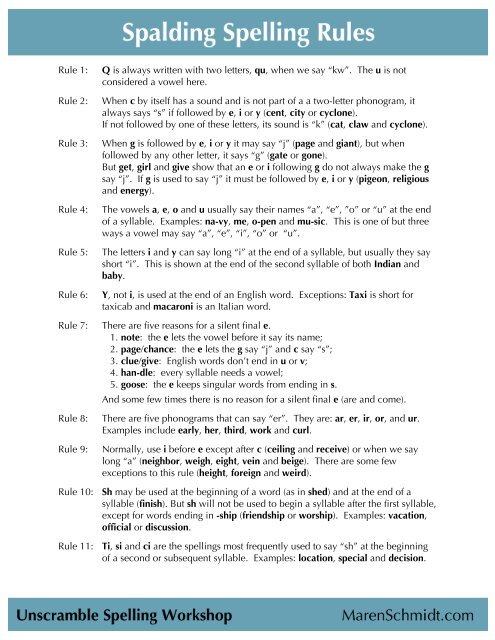Spelling Rules - Maren Schmidt
Spelling Rules - Maren Schmidt
Spelling Rules - Maren Schmidt
- No tags were found...
You also want an ePaper? Increase the reach of your titles
YUMPU automatically turns print PDFs into web optimized ePapers that Google loves.
Rule 1:Rule 2:Rule 3:Rule 4:Rule 5:Rule 6:Q is always written with two letters, qu, when we say “kw”. The u is notconsidered a vowel here.When c by itself has a sound and is not part of a a two-letter phonogram, italways says “s” if followed by e, i or y (cent, city or cyclone).If not followed by one of these letters, its sound is “k” (cat, claw and cyclone).When g is followed by e, i or y it may say “j” (page and giant), but whenfollowed by any other letter, it says “g” (gate or gone).But get, girl and give show that an e or i following g do not always make the gsay “j”. If g is used to say “j” it must be followed by e, i or y (pigeon, religiousand energy).The vowels a, e, o and u usually say their names “a”, “e”, ”o” or “u” at the endof a syllable. Examples: na-vy, me, o-pen and mu-sic. This is one of but threeways a vowel may say “a”, “e”, “i”, “o” or “u”.The letters i and y can say long “i” at the end of a syllable, but usually they sayshort “i”. This is shown at the end of the second syllable of both Indian andbaby.Y, not i, is used at the end of an English word. Exceptions: Taxi is short fortaxicab and macaroni is an Italian word.Rule 7: There are five reasons for a silent final e.1. note: the e lets the vowel before it say its name;2. page/chance: the e lets the g say “j” and c say “s”;3. clue/give: English words don’t end in u or v;4. han-dle: every syllable needs a vowel;5. goose: the e keeps singular words from ending in s.And some few times there is no reason for a silent final e (are and come).Rule 8:Rule 9:There are five phonograms that can say “er”. They are: ar, er, ir, or, and ur.Examples include early, her, third, work and curl.Normally, use i before e except after c (ceiling and receive) or when we saylong “a” (neighbor, weigh, eight, vein and beige). There are some fewexceptions to this rule (height, foreign and weird).Rule 10: Sh may be used at the beginning of a word (as in shed) and at the end of asyllable (finish). But sh will not be used to begin a syllable after the first syllable,except for words ending in -ship (friendship or worship). Examples: vacation,official or discussion.Rule 11: Ti, si and ci are the spellings most frequently used to say “sh” at the beginningof a second or subsequent syllable. Examples: location, special and decision.
Rule 12: Si is used to say “sh” when the syllable before it ends in an s (ses-sion) andwhen the base word has an s where the word changes (tense to ten-sion).Rule 13: Si – but not ti or ci – can also say “zh” as in vision.Rule 14: Words or one syllable (like hop) ending in a consonant, which have only onevowel before this last consonant, need another consonant before adding anending that begins with a vowel. Rule 14 does not apply to words ending in x(box-ing, ox-en).Rule 15: Words of two syllables, like begin, where the second syllable (-gin) is accentedand like hop, end in a consonant with one vowel before it, also need anotherconsonant before adding an ending that begins with a vowel. Americans haveused this rule more consistently than have the English.Rule 16: Words ending with one of the five kinds of silent e are written without the ewhen adding an ending that begins with a vowel. When the ending begins witha vowel and is not e, i, or y, the silent e is retained so that g can say “j” as inchangeable, or so the c can say “s” as in noticeable. <strong>Rules</strong> 2 and 3 explainthis.Rule 17: We often double l, f and s after a single vowel at the end of a one syllable word(hill, off, glass and roll). You will also see words like recess, distaff, egg andadd.Rule 18: Base words do not end with the letter a saying long “a”. Ay is used most often.The exception would be the article a.Rule 19: Vowels i and o may say long “i” and long “o” if followed by two consonants(find or old).Rule 20: S never follows x. There is already an “s” sound in x (the “ks”). Unless a cfollowed by e, i or y can be used (as in ex-cept) there cannot be a second “s”sound following an x.Rule 21: All, written alone, has double l, but when written with another syllable onlyone l is written (al-der, al-so, al-most).Rule 22: Till and full added to another syllable are written with one l (until, careful,joyful, beautiful).Rule 23: The letters dge may be used only after a single vowel which say the short “a”,“e”, “i”, “o” or “u” (badge, edge, bridge, lodge or budge).Rule 24: When adding an ending to a word that ends with a consonant and y, changethe y to i, unless the ending is -ing (baby, babies or try, tried, trying). InEnglish, we almost never have an i follow another i. In the words played orboys, we do not change the y because the y is preceded by a vowel.






